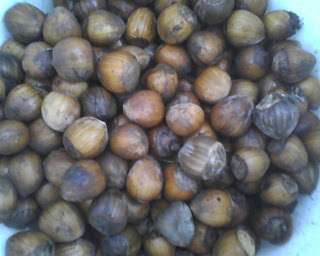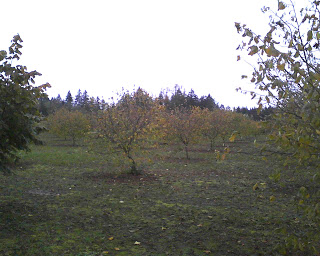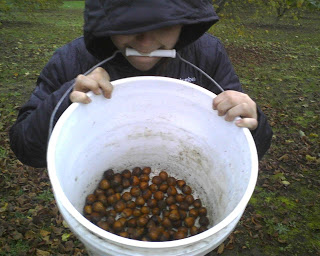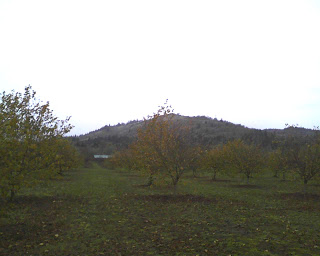For those of you who are unfamiliar, the name “hazelnut” applies to the nuts of any of the species of the genus Corylus. Oregon is the primary area where this crop is cultivate in the United States, and our locale is home to a variety of cultivars. Here is an interesting historical context from Wikipedia:
The evidence consists of a large, shallow pit full of the remains of
hundreds of thousands of burned hazelnut shells. Hazelnuts have been
found on other Mesolithic sites, but rarely in such quantities or
concentrated in one pit. The nuts were radiocarbon dated to 7720+/-110BP, which calibrates to circa 7000 BC. Similar sites in Britain are known only at Farnham in Surrey and Cass ny Hawin on the Isle of Man. This discovery gives an insight into communal activity and planning
in the period. The nuts were harvested in a single year, and pollen analysis suggests the hazel trees were all cut down at the same time.
The scale of the activity, unparalleled elsewhere in Scotland, and the
lack of large game on the island, suggest the possibility that Colonsay
contained a community with a largely vegetarian diet for the time they
spent on the island. The pit was originally on a beach close to the
shore, and was associated with two smaller, stone-lined pits, whose
function remains obscure, a hearth, and a second cluster of pits.
Cobnuts are still traditionally sold fresh, it has been speculated this
was done to make them more digestible for children. Toasting the nuts
also was thought to increase how long they would keep, and they have
historically been a useful food for mariners because they keep well.
Britain, although there is no evidence that they spread specific
cultivars. Cultivated varieties have been grown since at least the 16th
century, with a great increase in varieties during the 1800s; in
particular, the first really widespread cultivar, the Kentish Cobnut,
was introduced in 1830.
‘brutting’, which involves prompting more of the trees’ energy to go
into flower bud production, by snapping but not breaking off the tips of
the new year’s shoots six or seven leaf groups from the join with the
trunk or branch, at the end of the growing season. The traditional term
for an area of cultivated hazelnuts is a plat.”
“The Celts believed hazelnuts gave one wisdom and inspiration. There are numerous variations on an
ancient tale that nine hazel trees grew around a sacred pool, dropping
into the water nuts that were eaten by salmon (a fish sacred to Druids)
which absorbed the wisdom. The number of spots on the salmon were said
to indicate how many nuts they had eaten. A Druid teacher, in his bid to become omniscient, caught one of these
special salmon and asked a student to cook the fish, but not to eat it.
While he was cooking it, hot liquid from the cooking fish splashed onto
the pupil’s thumb, which he naturally sucked to cool, thereby absorbing
the fish’s wisdom. This boy was called Fionn Mac Cumhail (Fin McCool) and went on to become one of the most heroic leaders in Gaelic mythology.”




Wow, that's all really neat! I am amazed that they keep so well. The nuts we have here–hickory, walnuts, chestnuts and acorns–all spoil (or sprout insects) quickly.
We must be lucky. I still have my baskets of nuts out on the porch to finish processing. Maybe if you hit yours at just the right time, you could beat the bugs. Hickory nuts sound delightful!
HA! I know I only know you through the blog and comments but I left my acorns outside and suddenly found out there's quite a squirrel population in my neighborhood! The nuts are gone, and there's a mess of shells for me to clean up. It was fun, and at least someone enjoyed them… Next year I will have to store them inside.
Still reading and enjoying,
Nerissa
That is so funny. I guess where there are nuts, there are squirrels! Thanks for reading and for your wonderful comments.